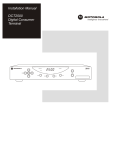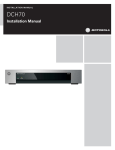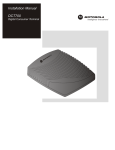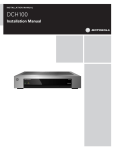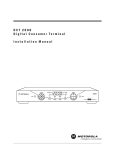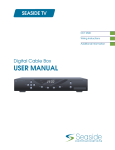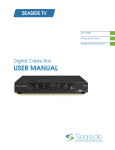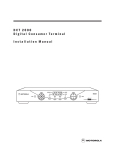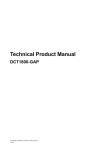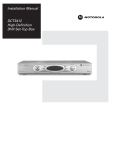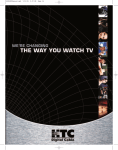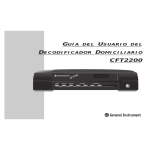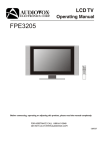Download Motorola DCT1800 Installation manual
Transcript
Installation Manual DCT1800 Digital ConsumerTerminal Graphical symbols and supplement warning marking locations on the bottom of the appliance. This symbol indicates that dangerous voltage levels are present within the equipment. These voltages are not insulated and may be of sufficient strength to cause serious bodily injury when touched. The symbol may also appear on schematics. This symbol calls attention to a critical procedure, or means refer to the instruction manual for opening or service information. Only qualified service personnel are to install or service the equipment. The symbol may also appear in text and on schematics. WARNING: TO PREVENT FIRE OR SHOCK HAZARD, DO NOT EXPOSE THIS APPLIANCE TO RAIN OR MOISTURE. CAUTION: TO PREVENT ELECTRICAL SHOCK, DO NOT USE THIS PLUG WITH AN EXTENSION CORD, RECEPTACLE, OR OTHER OUTLET UNLESS THE BLADES CAN BE FULLY INSERTED TO PREVENT BLADE EXPOSURE. FCC Compliance: Federal Communications Commission Radio and Television Interface Statement for a Class ‘B’ Device This equipment has been tested and found to comply with the limits for a Class B digital device, pursuant to part 15 of the FCC Rules. These limits are designed to provide reasonable protection against harmful interference in the residential installation. This equipment generates, uses and can radiate radio frequency energy and, if not installed and used in accordance with the instructions, may cause harmful interference to radio communications. However, there is no guarantee that interference will not occur in a particular installation. If the equipment does cause harmful interference to radio or television reception, which can be determined by turning the equipment off and on, the user is encouraged to try to correct the interference by one of the following measures: ! Reorient or relocate the receiver antenna ! Increase the separation between the equipment and the affected receiver ! Connect the equipment into an outlet or on a circuit different from that to which the receiver is connected ! Consult the dealer or experienced radio/TV technician for help ! Ensure that the cover plate for the security card is secured and tight Changes or modification not expressly approved by the party responsible for compliance could void the user’s authority to operate the equipment. Declaration of Conformity: According to 47 CFR, Parts 2 and 15 for Class B Personal Computers and Peripherals; and/or CPU Boards and Power Supplies used with Class B Personal Computers, Motorola, Inc., 6450 Sequence Drive, San Diego, CA 92121, 1-800-225-9446, declares under sole responsibility that the product identifies with 47 CFR Part 2 and 15 of the FCC Rules as a Class B digital device. Each product marketed is identical to the representative unit tested and founded to be compliant with the standards. Records maintained continue to reflect the equipment being produced can be expected to be within the variation accepted, due to quantity production and testing on a statistical basis as required by 47 CFR 2.909. Operation is subject to the following condition: This device must accept any interference received, including interference that may cause undesired operation. The above named party is responsible for ensuring that the equipment complies with the standards of 47 CFR, Paragraphs 15.107 to 15.109 Repairs: If repair is necessary, call the Motorola Repair Facility at 1-800-227-0450 for a Return for Service Authorization (RSA) number before sending the unit. The RSA number must be prominently displayed on all equipment cartons. Pack the unit securely; enclose a note describing the exact problem, and a copy of the invoice that verifies the warranty status. Ship the unit PRE-PAID to the following address: Motorola, Inc. Attn: RSA #___________ c/o Rudolph Miles and Sons 2500 Courage Boulevard Brownsville, TX 78521 NOTE TO CATV SYSTEM INSTALLER: This reminder is provided to call CATV system installer’s attention to Article 820-40 of the NEC that provides guidelines for proper grounding and, in particular, specifies that the cable ground shall be connected to the grounding system of the building, as close as possible to the point of cable entry as practical. Copyright © 2003 Motorola, Inc. All rights reserved. No part of this publication may be reproduced in any form or by any means or used to make any derivative work (such as translation, transformation or adaptation) without written permission from Motorola, Inc. Motorola reserves the right to revise this publication and to make changes in content from time to time without obligation on the part of Motorola to provide notification of such revision or change. Motorola provides this guide without warranty of any kind, either implied or expressed, including but not limited to, the implied warranties of merchantability and fitness for a particular purpose. Motorola may make improvements or changes in the product(s) described in this manual at any time. © Motorola, Inc. 2003 MOTOROLA and the Stylized M Logo are registered in the US Patent & Trademark Office. Starvue and Starfone are registered trademarks of Motorola, Inc. Dolby Surround is a registered trademark of Dolby Laboratories Licensing Corporation. All other product or service names are the property of their respective owners. Contents Section 1 Introduction Using This Manual ........................................................................................................................................................................... 1-2 Related Documentation................................................................................................................................................................... 1-2 Document Conventions................................................................................................................................................................... 1-2 If You Need Help .............................................................................................................................................................................. 1-3 Calling for Repairs ........................................................................................................................................................................... 1-3 Section 2 Overview Front Panel ....................................................................................................................................................................................... 2-1 Rear Panel ........................................................................................................................................................................................ 2-2 Remote Controls .............................................................................................................................................................................. 2-3 Motorola Universal Remote Control.......................................................................................................................................2-3 Installing Batteries in Remote Control...................................................................................................................................2-5 Section 3 Installation Before You Begin............................................................................................................................................................................. 3-1 Installing the DCT1800 .................................................................................................................................................................... 3-1 Standard Cabling Diagram.............................................................................................................................................................. 3-2 Standard VCR Cabling Diagram ..................................................................................................................................................... 3-3 Composite Baseband Cabling Diagrams ...................................................................................................................................... 3-4 Stereo Cabling Diagram (Baseband) ............................................................................................................................................. 3-6 A/V Receiver Cabling Diagrams ..................................................................................................................................................... 3-8 Operational Check ........................................................................................................................................................................... 3-9 Cold Initialization ............................................................................................................................................................................. 3-9 DCT1800 Installation Manual ii Contents Section 4 Troubleshooting Appendix A Specifications Appendix B Diagnostics Accessing Diagnostics ................................................................................................................................................................... B-1 Navigating the Diagnostics ............................................................................................................................................................ B-2 d 01: General Status........................................................................................................................................................................ B-3 Error Codes............................................................................................................................................................................. B-4 d 02: Out-of-Band (OOB) Status .................................................................................................................................................... B-6 Selecting the OOB Frequency............................................................................................................................................... B-7 d 03: In-band Status ........................................................................................................................................................................ B-8 d 04: Audio/Video Status .............................................................................................................................................................. B-10 d 05: Unit Address......................................................................................................................................................................... B-11 d 06: Firmware Version................................................................................................................................................................. B-12 d 07: Current Channel Status....................................................................................................................................................... B-13 Current Channel Variables .................................................................................................................................................. B-15 d 08: Renewable Security System ............................................................................................................................................... B-16 d 09: Upstream Modem (STARVUE II Diagnostics).................................................................................................................... B-17 d 10: Application (APP) Code Modules....................................................................................................................................... B-18 d 11: Memory Status ..................................................................................................................................................................... B-19 d 12: Interactive Info ..................................................................................................................................................................... B-20 d 13: MAC Frequency Table ......................................................................................................................................................... B-21 d 14: Message Types .................................................................................................................................................................... B-22 d 15: In-band Program Association Table (PAT)........................................................................................................................ B-23 d 16: In-band Program Map Table (PMT)..................................................................................................................................... B-23 d 17: Task Status........................................................................................................................................................................... B-23 d 18: In-band Multicast Address Filter ........................................................................................................................................ B-24 d 19: Keyboard / LED Diagnostics............................................................................................................................................... B-25 Abbreviations and Acronyms DCT1800 Installation Manual Contents iii Figures Figure 1-1 DCT1800 advanced set-top.......................................................................................................................................... 1-1 Figure 2-1 DCT1800 front panel...................................................................................................................................................... 2-1 Figure 2-2 DCT1800 rear panel ...................................................................................................................................................... 2-2 Figure 2-3 Motorola universal remote control ............................................................................................................................. 2-3 Figure 2-4 Back view of remote control........................................................................................................................................ 2-5 Figure 3-1 Standard cabling .......................................................................................................................................................... 3-2 Figure 3-2 Standard VCR cabling.................................................................................................................................................. 3-3 Figure 3-3 Standard baseband cabling......................................................................................................................................... 3-4 Figure 3-4 Composite VCR cabling............................................................................................................................................... 3-5 Figure 3-5 Audio through the VCR................................................................................................................................................ 3-6 Figure 3-6 Audio through VCR/audio output on TV .................................................................................................................... 3-7 Figure 3-7 Audio through A/V Receiver........................................................................................................................................ 3-8 Figure B-1 DIAGNOSTICS Main Menu ..........................................................................................................................................B-2 Figure B-2 DCT1800 Status............................................................................................................................................................B-3 Figure B-3 OOB Diagnostic ...........................................................................................................................................................B-6 Figure B-4 In-band Diagnostic.......................................................................................................................................................B-8 Figure B-5 Audio/Video Status ....................................................................................................................................................B-10 Figure B-6 Unit Address...............................................................................................................................................................B-11 Figure B-7 Firmware Version.......................................................................................................................................................B-12 Figure B-8 Current Channel Status.............................................................................................................................................B-13 Figure B-9 Renewable Security ...................................................................................................................................................B-16 Figure B-10 STARVUE II Diagnostic ...........................................................................................................................................B-17 Figure B-11 APP Code Modules ..................................................................................................................................................B-18 Figure B-12 Memory Status .........................................................................................................................................................B-19 Figure B-13 Interactive Info .........................................................................................................................................................B-20 Figure B-14 MAC Frequency Table .............................................................................................................................................B-21 Figure B-15 Message Types ........................................................................................................................................................B-22 Figure B-16 In-band PAT..............................................................................................................................................................B-23 Figure B-17 In-band PMT .............................................................................................................................................................B-23 Figure B-18 Task Status...............................................................................................................................................................B-23 Figure B-19 In-band Multicast Address Filter ............................................................................................................................B-24 Figure B-20 Keyboard / LED Diagnostics...................................................................................................................................B-25 DCT1800 Installation Manual iv Contents Tables Table 2-1 Rear panel .......................................................................................................................................................................2-2 Table 2-2 Remote control keys .......................................................................................................................................................2-4 Table 3-1 Operational check...........................................................................................................................................................3-9 Table 4-1 Troubleshooting guidelines...........................................................................................................................................4-1 Table B-1 Operational keys using the diagnostics main menu or submenus ......................................................................... B-2 Table B-2 Diagnostic Main Menu Fields....................................................................................................................................... B-4 Table B-3 Error codes .................................................................................................................................................................... B-4 Table B-4 OOB Diagnostic Fields ................................................................................................................................................. B-6 Table B-5 In-band Diagnostic Fields ............................................................................................................................................ B-8 Table B-6 Audio Video Status fields........................................................................................................................................... B-10 Table B-7 Unit Address Fields ................................................................................................................................................... B-11 Table B-8 Current Channel Status Fields .................................................................................................................................. B-14 Table B-9 Current Channel Status Variables............................................................................................................................. B-15 Table B-10 Renewable Security Fields....................................................................................................................................... B-16 Table B-11 STARVUE II Transmitter Fields................................................................................................................................ B-17 Table B-12 APP Code Modules Fields........................................................................................................................................ B-18 Table B-13 Memory Status Fields............................................................................................................................................... B-19 Table B-14 Interactive Info Fields ............................................................................................................................................... B-20 Table B-15 MAC Frequency Table Fields................................................................................................................................... B-21 Table B-16 Message Types Fields ............................................................................................................................................... B-22 Table B-17 In-Band Multicast Address Filter Fields ................................................................................................................. B-24 DCT1800 Installation Manual Section 1 Introduction The Motorola DCT1800 is an analog/digital set-top that supports 64 and 256 QAM digital signal formats. The DCT1800 is compatible with existing Motorola analog and digital set-top products. The Motorola DCT1800 offers: ! 54 through 860 MHz integrated tuner ! Integrated RF return (using built-in STARVUE II module) ! RF and baseband audio/ video ports ® Figure 1-1 illustrates front and rear views of the DCT1800: Figure 1-1 DCT1800 advanced set-top TO TV/VCR TO RF IN RF IN CABLE IN AUDIO OUT R L VIDEO TV Pass Card DCT1800 Installation Manual 1-2 Introduction Using This Manual This manual provides instructions to install and configure a DCT1800: Section 1 Introduction provides a product description, a list of related documentation, the technical helpline telephone number, and the repair/return procedure. Section 2 Overview describes the DCT1800 and provides an overview of its use. This section also identifies the front-panel displays and switches and describes the rear-panel features. Section 3 Installation provides instructions on how to install the DCT1800 in a subscriber location and perform operational tests. Section 4 Troubleshooting provides guidelines for troubleshooting the equipment. Appendix A Specifications provide the technical specifications for the DCT1800. Appendix B Diagnostics provide instructions on accessing and interpreting the built-in diagnostics. Abbreviations and Acronyms The Abbreviations and Acronyms list contains the full spelling of the short forms used in this manual. Related Documentation Separate instruction manuals are available for associated components. Although these may be useful, they are not necessary to install or operate the DCT1800: ! DCT1800 User Guide Document Conventions Before you begin working with this manual and using the DCT1800, familiarize yourself with the stylistic conventions used in this manual: SMALL CAPS Denotes silk screening on the equipment, typically representing front- and rear-panel controls, input/output (I/O) connections, and LEDs * (asterisk) Indicates that several versions of the same model number exist and the information applies to all models; when the information applies to a specific model, the complete model number is given Italic type Used for emphasis Courier font Displayed text DCT1800 Installation Manual Introduction 1-3 If You Need Help If you need assistance while working with the DCT1800, contact the Motorola Technical Response Center (TRC): ! Inside the U.S.: 1-888-944-HELP (1-888-944-4357) ! Outside the U.S.: 215-323-0044 ! Online: http://broadband.motorola.com/noflash/websupport.html. The TRC is open from 8:00 AM to 2:00 AM Eastern Time, Monday through Friday and 10:00 AM to 5:00 PM Eastern Time, Saturday. When the TRC is closed, emergency service only is available on a call-back basis. Web Support offers a searchable solutions database, technical documentation, and low priority issue creation/tracking 24 hours per day, 7 days per week. Calling for Repairs If repair is necessary, call the Motorola Repair Facility at 1-800-227-0450 for a Return for Service Authorization (RSA) number before sending the unit. The RSA number must be prominently displayed on all equipment cartons. The Repair Facility is open from 8:00 AM to 5:00 PM Central Time, Monday through Friday. When calling from outside the United States, use the appropriate international access code and then call 956-541-0600 to contact the Repair Facility. When shipping equipment for repair, follow these steps: 1 Pack the unit securely. 2 Enclose a note describing the exact problem. Complete and enclose the checklist provided with the unit. 3 Enclose a copy of the invoice that verifies the warranty status. Ship the unit PREPAID to the following address: Motorola, Inc. Broadband Communications Sector Attn: RSA #___________ c/o Rudolph Miles and Sons 2500 Courage Boulevard Brownsville, TX 78521 DCT1800 Installation Manual Section 2 Overview The DCT1800 uses digital compression technology to provide new revenue generating services. The DCT1800 can be configured to support real time reverse path communications, providing a gateway to interactive services such as Video on Demand (VOD), Internet access, e-mail, home shopping, and more. This section provides illustrations and tables showing the DCT1800 displays and connectors. Before you begin to install the DCT1800, familiarize yourself with the various controls and displays. Front Panel The front panel of the DCT1800 has two LED displays: one to indicate the unit is turned on and one to indicate a message is present. Figure 2-1 illustrates the front panel: Figure 2-1 DCT1800 front panel The DCT1800 is operated by using the Motorola universal remote control. See “Remote Controls” in this section for information on operating the DCT1800. DCT1800 Installation Manual 2-2 Overview Rear Panel Figure 2-2 illustrates the rear panel of the DCT1800, which contains a power connection and connectors for video, audio, and RF cabling: Figure 2-2 DCT1800 rear panel 1 2 3 4 5 AUDIO OUT R L VIDEO TO RF IN TO TV/VCR RF IN TV Pass Card CABLE IN 6 7 8 Table 2-1 describes each of the rear-panel features: Table 2-1 Rear panel Key Item 1 TO TV/VCR Function F-type connector used to connect the DCT1800 to a standard TV or VCR F-type connector used for DCT1800 input from the TO RF IN connector 2 RF IN 3 TO RF IN 4 AUDIO OUT R L 5 VIDEO F-type connector used to connect the TO RF IN port to the RF IN port (output from integrated RF return) Left and right audio RCA jacks used for stereo audio output RCA jack used to connect the DCT1800 to a composite (baseband) video TV or a monitor; in some configurations this jack connects to a VCR F-type connector used for the coaxial cable input port from plant (input to integrated RF return) 6 CABLE IN 7 TV Pass Card 8 DCT1800 Installation Manual Cover for an area reserved for future use AC power outlet that can be configured as a switched or unswitched outlet Overview 2-3 Remote Controls The DCT1800 uses a Motorola universal remote control to operate. If your system offers optional interactive applications, such as an interactive program guide, a different remote control may be required. The application provider should supply user instructions for each interactive application. Motorola Universal Remote Control Figure 2-3 illustrates the remote control: Figure 2-3 Motorola universal remote control 1 AU DIO 2 3 4 5 6 7 8 VCR/D VD CA BLE HELP PAGE 11 12 POWER LOCK PAGE INFO EXIT 14 15 16 OK MENU VOLUME 9 10 TV LAST CH ANNEL FAVOR ITE 19 THEME LIST CA NCEL A B C 1 2 3 4 5 6 7 8 TV/VCR REW PAUSE RECORD 20 9 ENTER 0 DAY STOP 17 18 DAY PLAY 21 F.FWD 13 DCT1800 Installation Manual 2-4 Overview Table 2-2 describes the remote control keys: Table 2-2 Remote control keys Key Item 1 AUDIO, VCR/DVD, CABLE, or TV 2 HELP 3 POWER 4 PAGE ▲ or PAGE▼ ▼ 5 EXIT 6 Description Selects a desired device to control. The selected mode will remain active until you press another device key. Displays the help screen. Turns the selected home entertainment component on or off. Pages through menu screens and the program guide. Exits a menu or program guide. Moves the cursor around the program guide and menu screens. 7 OK 8 GUIDE 9 VOLUME + or VOLUME - 10 A, B, or C 11 NUMBER KEYS 12 TV/VCR BYPASS 13 ◄ Day Day ► STOP, PAUSE, PLAY, REW, RECORD, F.FWD Selects menu options, Pay-Per-View events or tune programs from the program guide. Your remote may only have OK; this key still performs the same functions. Displays the program guide. Increases or decreases the volume of the currently selected device. Functionality is determined from services offered by the service provider. Directly selects a channel. When in VCR mode, toggles between television and VCR. Bypass is not available. Moves the program guide ahead or back 24 hours. Controls the VCR. 14 MUTE Toggles the sound on and off. 15 LOCK Limits viewing of selected programs; and is used to view the Pay-Per-View menu. Your remote may have only LOCK; this key still performs the same functions. 16 INFO Displays the current channel and program information (not supported by all applications). 17 MENU Displays the main menu. 18 LAST Recalls the last channel or goes back one screen in the menu. 19 CHANNEL + or - 20 FAVORITE 21 ENTER/MUSIC DCT1800 Installation Manual Changes the channels by moving up or down. Displays preset favorite cable channels. Displays digital music channel menus. On some TV models, press to enter channels. Overview 2-5 Installing Batteries in Remote Control Before using the remote control, you must install two AA (1.5 V) alkaline batteries. Figure 2-4 illustrates battery access on the back of the remote control. To install batteries in a Motorola universal remote control: 1 Press and slide the battery compartment cover off. 2 Place the batteries in the compartment; be careful to observe the correct polarity. 3 Slide the battery compartment cover back into place. Battery installation will vary with each style of remote control. Refer to the instructions included with your remote control for installing batteries. Figure 2-4 Back view of remote control + + NOTE! Use and dispose of batteries in accordance with all applicable laws, rules and regulations. Motorola will not be liable to anyone for the user's failure to use and/or dispose of batteries in the proper manner and in accordance with such laws, rules and regulations, or for any defect contained in batteries that may cause injury damage to persons or property. DCT1800 Installation Manual Section 3 Installation This section provides instructions for installing and cabling the DCT1800. To complete the installation, you must: ! Connect the cables ! Supply power to equipment ! Download configuration information and software ! Run operational check and diagnostics This section also includes the procedure for performing a cold initialization of the DCT1800. Before You Begin Before you begin, review the installation instructions, gather the required items, and complete the tasks listed below: ! Verify that you have 75-ohm coaxial cables with F-type connectors and RCA baseband phono-type cables. ! Determine if you are connecting the DCT1800 to a standard TV or a composite (baseband) monitor. ! Place the DCT1800 on a smooth, flat surface and remove any obstructions that could interfere with the free flow of air over, under, or around it. Advise the subscriber not to place anything on top of the unit. Installing the DCT1800 To install the DCT1800: 1 Determine if you are connecting the DCT1800 to a conventional TV or to a monitor. To install the video connection: ! For a conventional TV, use a 75-ohm coaxial cable with F-type connectors. ! For a monitor, use an RCA phono cable to connect the VIDEO connector to the monitor. 2 Locate the cabling diagram that matches the subscriber’s configuration requirement. 3 Connect the cables as illustrated in the diagram. 4 Perform the basic operational check in this section after the DCT1800 is installed. DCT1800 Installation Manual 3-2 Installation Standard Cabling Diagram The DCT1800 will output on either channel 3 or 4 depending on the configuration message from the control system. Figure 3-1 illustrates a standard diagram connecting the DCT1800 to a TV using RF connectors: Figure 3-1 Standard cabling DCT1800 TO TV/VCR AUDIO OUT L R TO RF IN VIDEO RF IN TV Pass Card CABLE IN From cable outlet AUDIO IN R L AUDIO OUT CABLE IN R L VIDEO IN SVIDEO IN TV The remodulated channel, 3 or 4, does not carry stereo for digital channels. To receive stereo, connect the DCT1800 using RCA baseband connectors. These connections are illustrated later in this section. DCT1800 Installation Manual Installation 3-3 Standard VCR Cabling Diagram Figure 3-2 illustrates the basic cabling diagram that enables you to record the channel being viewed: Figure 3-2 Standard VCR cabling DCT1800 TO TV/VCR AUDIO OUT R L TO RF IN VIDEO RF IN TV Pass Card CABLE IN From cable source AUDIO IN CABLE IN AUDIO R IN L VIDEO IN R SVIDEO IN CABLE IN CABLE OUT VCR AUDIO R OUT L R VIDEO OUT SVIDEO OUT L AUDIO OUT L VIDEO IN SVIDEO IN TV The remodulated channel, 3 or 4 does not carry stereo for digital channels. To receive stereo, connect the DCT1800 using RCA baseband connectors. These connections are illustrated later in this section. DCT1800 Installation Manual 3-4 Installation Composite Baseband Cabling Diagrams Connecting the DCT1800 using the baseband RCA type outputs enables the subscriber to experience stereo and Dolby Surround sound when available on digital channels. Figure 3-3 illustrates the standard baseband audio and video outputs of the DCT1800: Figure 3-3 Standard baseband cabling DCT1800 TO TV/VCR AUDIO OUT R L TO RF IN VIDEO RF IN TV Pass Card CABLE IN AUDIO IN R CABLE IN R TV DCT1800 Installation Manual L AUDIO OUT VIDEO IN L SVIDEO IN Installation 3-5 Figure 3-4 illustrates baseband audio and video connections to a VCR and TV: Figure 3-4 Composite VCR cabling DCT1800 TO TV/VCR AUDIO OUT R L TO RF IN VIDEO RF IN TV Pass Card CABLE IN CABLE IN CABLE OUT R AUDIO IN L AUDIO R OUT L VIDEO IN SVIDEO IN VIDEO OUT SVIDEO OUT VCR AUDIO IN R L AUDIO OUT CABLE IN R L VIDEO IN SVIDEO IN TV DCT1800 Installation Manual 3-6 Installation Stereo Cabling Diagram (Baseband) This audio configuration does not provide for a TV playing through the stereo. Figure 3-5 illustrates how to connect the DCT1800 to a stereo using the audio connectors on the VCR: Figure 3-5 Audio through the VCR DCT1800 TO TV/VCR AUDIO OUT L R TO RF IN VIDEO RF IN TV Pass Card CABLE IN CABLE IN CABLE OUT R AUDIO IN L AUDIO R OUT L VIDEO IN SVIDEO IN VIDEO OUT SVIDEO OUT VCR AUDIO IN R R STEREO DCT1800 Installation Manual AUDIO OUT AUDIO IN L R L R TV L AUDIO OUT CABLE IN VIDEO SVIDEO IN IN L Installation 3-7 This audio configuration enables the TV to play through the stereo. Figure 3-6 shows how to connect the DCT1800 to a stereo using the audio loop-through connectors on the VCR and the audio output ports on the TV monitor: Figure 3-6 Audio through VCR/audio output on TV DCT1800 TO TV/VCR AUDIO OUT R L TO RF IN VIDEO RF IN TV Pass Card CABLE IN CABLE IN CABLE OUT R AUDIO IN L AUDIO R OUT L VIDEO IN SVIDEO IN VIDEO OUT SVIDEO OUT VCR AUDIO IN R L AUDIO OUT CABLE IN R L VIDEO IN SVIDEO IN TV AUDIO IN R L AUDIO OUT R L STEREO DCT1800 Installation Manual 3-8 Installation A/V Receiver Cabling Diagrams Using this configuration, the audio/video signals are passed through the digital receiver to enable the VCR record and playback features. Figure 3-7 illustrates audio/video connections for an A/V receiver: Figure 3-7 Audio through A/V Receiver DCT1800 TO TV/VCR AUDIO OUT R L TO RF IN VIDEO RF IN TV Pass Card CABLE IN A/V RECEIVER In Monitor out S-Video Video Video 2 Video 1 In Coaxial Out Optical VCR CABLE IN CABLE OUT AUDIO IN AUDIO OUT VIDEO IN L R R L SVIDEO IN VIDEO OUT SVIDEO OUT TV AUDIO IN R R DCT1800 Installation Manual L AUDIO OUT CABLE IN L VIDEO IN SVIDEO IN Installation 3-9 Operational Check The operational check tests the communication link between the remote control and the DCT1800. The procedures verify the DCT1800 response to remote control commands. Table 3-1 lists the operational check procedures: Table 3-1 Operational check Feature Testing Procedure Power on ! ! Channel Selection Press POWER to turn on the DCT1800. Turn on the TV and tune it to the output channel of the DCT1800 (channel 3 or 4). Tune to several channels by entering the channel number with the numeric keys on the remote control. If the DCT1800 does not operate properly, refer to Section 4, “ Troubleshooting” . Cold Initialization The DCT1800 has no front panel buttons. To perform a cold initialization, or reset, use the remote control. To execute a cold initialization: 1 Hold down any key on the remote control while disconnecting and reconnecting AC power to the DCT1800. After booting up, the POWER LED on the DCT1800 front panel will flash. 2 Within 3 seconds, press the 3 key on the remote control. The POWER LED on the DCT1800 front panel flashes at a decreased rate. 3 Within 3 seconds, press the 2 key on the remote control. The POWER LED on the DCT1800 front panel flashes at an increased rate. 4 Within 3 seconds, press the 8 key on the remote control to initiate the cold reset. During the cold initialization procedure, if the appropriate remote control key is not pressed within the three-second time period, the procedure terminates and the DCT1800 resumes normal operation. DCT1800 Installation Manual Section 4 Troubleshooting This section provides information to assist you in quickly detecting, isolating, and resolving error conditions that might occur when using the DCT1800. If you need assistance, call the Motorola Technical Resource Center (TRC): ! Inside the U.S.: 1-888-944-HELP (1-888-944-4357) ! Outside the U.S.: 215-323-0044 Table 4-1 is a list of possible problems and solutions: Table 4-1 Troubleshooting guidelines Problem Possible Solution No power to the DCT1800 Check the power outlet for AC power. Be sure the TV is tuned to the output channel of the DCT1800 (channel 3 or 4). Verify that cable connections are correct from the TV set or monitor to the DCT1800. Check that the power cord is properly plugged into the outlet and DCT1800. Remote control is not responding Check for an obstruction between the remote control and the DCT1800. Aim the remote control directly at the DCT1800, not the TV or VCR. Be sure you firmly and deliberately press and release operation keys one at a time. Check that the DCT1800 has been initialized correctly; refer to Diagnostics. The DCT1800 is not receiving a cable signal Check the cable connections and hand-tighten if necessary. Verify that the cable connections are correct. Verify the TV is working and has a clear picture. Guide has no data Unplug the power to the DCT1800 and plug in the unit again. Wait for the DCT1800 to collect the data. DCT1800 Installation Manual Appendix A Specifications Input frequency 54 - 860 MHz (excluding data carrier frequency) HRC/IRC frequency assignments Downloadable Number of channels: 136 carriers per cable Analog 1 channel per carrier Digital More than 1 channel per carrier, content dependent Input analog video level 0 dBmV – +15 dBmV Input analog sound level –17 dBmV – +2 dBmV Average digital input level –10 dBmV – +5 dBmV Data carrier: QPSK-modulated carrier Frequency Agile Bandwidth 1.5 MHz Level –10 dBmV – +5 dBmV Video s/n 49 dB @ 0 dBmV input level Output frequency accuracy ±150 kHz Return loss: Input 6 dB minimum Output 8 dB minimum Spurious output –57 dBc maximum, in band Cross-modulation distortion –56 dB (136 channels, each @ +15 dBmV) Composite second order distortion –57 dB (136 channels, each @ +15 dBmV) Second order distortion –60 dB (136 channels, each @ +15 dBmV) Composite triple beat distortion –57 dB (136 channels, each @ +15 dBmV) Set-top input beats (with all input signals) –25 dB (136 channels, each @ +15 dBmV) Hum modulation distortion 3 IRE Output level 10 - 15 dBmV Isolation (input/output) 70 dB minimum Differential phase 10 degrees (maximum) On-screen display (OSD): Screen size 352 x 480 pixels (configuration dependent) Message/barker capacity Up to 40 pages (configuration dependent) Mechanical security Standard: security screws, unichassis construction Operating environment range: Temperature 0° - 40°C (32° through 104°F) Humidity 5 - 95% (noncondensing) DCT1800 Installation Manual A-2 Specifications ac voltage 105 – 125, 60 Hz Power dissipation 16 W at 115 Vac Surge protection Provided on power supply and RF ports Size 17.13 × 13.25 × 2.75 inches Weight 8.6 pounds DCT1800 Installation Manual Appendix B Diagnostics This section describes the diagnostics to confirm proper DCT1800 installation, including: ! Checking error states and signal integrity ! Identifying the set-top on the network ! Verifying communications with the headend The diagnostic information is displayed on the on-screen display (OSD). For the diagnostics provided here: ! All indicators are in decimal notation unless otherwise noted. ! All signal-level and quality indicators are based on a 0 to 100% scale, unless otherwise noted. ! All screens self-refresh at a minimum rate of once every five seconds. ! All sample displays are illustrative; actual data will differ from the examples. ! The screens are available for V7.72 code and higher. Accessing Diagnostics Use the Motorola universal remote control to operate the DCT1800. To access and navigate the diagnostic mode: 1 Press POWER on the remote control to turn on the set-top. 2 Wait five seconds and then press POWER again to turn off the set-top. 3 Press SELECT /OK on the remote control within two seconds after powering off. The DIAGNOSTICS main menu (Figure B-1) is displayed on the OSD. The set-top is now in diagnostic mode. 4 Use the CHANNEL keys on the remote control to select the desired diagnostic. 5 Press CURSOR <, CURSOR >, SELECT, or ENTER to execute the selected diagnostic. 6 To exit the diagnostic mode, press POWER on the remote control. The set-top exits the diagnostic mode and powers off. DCT1800 Installation Manual B-2 Diagnostics Navigating the Diagnostics Figure B-1 illustrates the DIAGNOSTICS main menu: Figure B-1 DIAGNOSTICS Main Menu DIAGNOSTICS 01 GENERAL STATUS 02 OOB STATUS 03 IN BAND STATUS 04 AUDIO/VIDEO STATUS 05 UNIT ADDRESS 06 FIRMWARE VERSION 07 CURRENT CHANNEL STATUS 08 RENEWABLE SECURITY 09 UPSTREAM MODEM 10 APP CODE MODULES 11 MEMORY CONFIG 12 INTERACTIVE INFO 13 MAC FREQUENCY TABLE 14 MESSAGE TYPES 15 IN BAND PAT 16 IN BAND PMT 17 TASK STATUS 18 IB MCA STATUS 19 KEYBOARD / LED Table B-1 Operational keys using the diagnostics main menu or submenus Key Key function using the diagnostics main menu Key function using a diagnostic POWER Exits diagnostic mode and enters OFF state Exits diagnostic mode and enters OFF state CH/CUR +, CURSOR UP Moves the cursor up Displays the DIAGNOSTICS main menu CH/CUR - , CURSOR DOWN Moves the cursor down Displays the DIAGNOSTICS main menu CURSOR RIGHT, CURSOR LEFT, SELECT, ENTER Runs the selected diagnostic Displays the DIAGNOSTICS main menu GUIDE No function No function MENU No function No function INFO No function No function DCT1800 Installation Manual Diagnostics B-3 d 01: General Status The general status diagnostic displays the error code, a short description of the error, the purchase count, and specific model information: Figure B-2 DCT1800 Status 01 DCT1800 STATUS ERROR : E 00 NO ERROR PURCHASES : 0 Platform ID: : 0x0060 Family ID : 0x0000 Model ID : 0x008F TUNER : V860DL Remod Channel : 3 Time Zone (hhhhhhhh) MMMM min DS Entry Time 1/1/1999 00:00 GMT DS Exit Time 1/1/1999 00:00 GMT Current GPS Time 1/1/1999 00:00 GMT DCT1800 Installation Manual B-4 Diagnostics Table B-2 Diagnostic Main Menu Fields Field Description Error Codes A sequence of LED flashes communicates errors when they occur. The Error Code field displays the code for the active error when appropriate. Connected State The state of the set-top is connected or disconnected. The connected state of the set-top is set by a DCT-operations connect or disconnect message. The OSD displays DISCONNECTED when the set-top is in the disconnected state and CONNECTED when it is in the connected state. Platform ID A 16-bit hexadecimal number used to differentiate between digital platform images in the field. It is also called the ROM ID. Family ID A hexadecimal number that indicates the set-top manufacturer and product family. Model ID A hexadecimal number that indicates the set-top model. Remod Channel The Remod Channel number can be 3 or 4 (NA systems). The output port configuration displays the configuration of the set-top output or re-modulated (remod) port. The output port/remod port is the interface from the set-top to the subscriber TV. Time Zone Indicates the time zone offset (in minutes) relative to GMT. DS Entry Time Indicates the daylight savings entry time. DS Exit Time Indicates the daylight savings exit time. Current GPS Time Indicates the current time. Error Codes A sequence of LED flashes communicates errors when errors occur. Table B-3 lists the error codes, associated flash sequences, causes, and remedies: Table B-3 Error codes Initialization Status Errors Code Flash Sequence Cause Remedy E 00 None; no error condition exists Indicates normal condition after initialization Not applicable E 01 MSG The set-top did not receive a connect message Restore out-of-band signal Send a connect message E 02 Repeating series of two MSG LED flashes, separated by a pause Init Error The set-top needs a power cycle to recover E 03 Repeating series of three MSG LED flashes, separated by a pause DRAM error Not used at this time E 04 Repeating series of four MSG LED flashes, separated by a pause DP-SRAM error Not used at this time LED flashes on and off DCT1800 Installation Manual Diagnostics B-5 Initialization Status Errors Code Flash Sequence Cause Remedy E 07 Repeating series of seven MSG LED flashes, separated by a pause ROM verification failure Power cycle the set-top; if repetitive, return for repair E 08 Repeating series of eight MSG LED flashes, separated by a pause Faulty RAM, ROM, EEPROM, or POST failure (this is a hardware failure) Return the set-top for repair E 09 Repeating series of nine MSG LED flashes, separated by a pause Dead battery or the memory has not been initialized; occurs if the battery fails to keep the RAM alive during power-down; causes set-top to be disconnected Return the set-top for repair; requires factory initialization message E 10 POWER LED flashes on MSG LED remains off Invalid serial number Not used at this time E 11 POWER LED flashes once; MSG LED flashes once Invalid unit address Return the set-top for repair; requires a unit creation message E 12 POWER LED flashes once; MSG LED flashes twice POST failed Not used at this time E 13 POWER LED flashes once; MSG LED flashes three times Sys_boot initialization failure Power cycle the set-top; if repetitive, return for repair E 14 POWER LED flashes once; MSG LED flashes four times System startup failure Power cycle the set-top; if repetitive, return for repair E 15 POWER LED flashes once; MSG LED flashes five times TSI structure is corrupted Power cycle the set-top; if repetitive, return for repair E 16 POWER LED flashes once; MSG LED flashes six times Bad flash number specified for Initiate Flash Platform Error logged, ignore E 17 POWER LED flashes once; MSG LED flashes seven times Bad platform validation step number Error logged, ignore and off; Only the V860DL AND ACD2204 tuner appear on the on-screen display. DCT1800 Installation Manual B-6 Diagnostics d 02: Out-of-Band (OOB) Status This diagnostic indicates the status of the out-of-band control channel. Figure B-3 OOB Diagnostic 02 OOB DIAGNOSTIC DATA * EMM DATA * CARRIER LOCK YES HUNT MODE None SNR 23 dB GOOD COUNT 1 CUR FREQ LKC EMM PRVDR ID 0x0001 Table B-4 OOB Diagnostic Fields Field Description Data The OSD indicates with a “*” that data has been received. The indicators cover all packet processors regardless of which stream they are monitoring and are cleared when you enter the diagnostic. EMM Data Indicates whether the set-top is receiving a message on the EMM stream with the following variables: Carrier Lock Hunt Mode Blank No data received * Data received The set-top can receive only six PIDs at once. Data on PIDs can be present on the out-of-band multiplex that the set-top is not receiving. The CARRIER LOCK is reset to “1” after an initialization from the DAC 6000 or a power cycle. Each time the set-top detects a drop in OOB connectivity, the counter increments. The following Carrier Lock variables can display: YES Carrier locked NO Carrier unlocked Indicates the state of OOB stream acquisition. The Hunt Mode can be: None The set-top is locked to an OOB carrier. RR (Round Robin) The set-top is searching OOB frequencies trying to find an EMM Provider of 0 or 1. EMM The set-top received a Provider ID change and is searching OOB frequencies for the new ID. FIX The set-top has been commanded to attempt to lock onto a frequency. SRCH The set-top at some point had a valid Provider ID on the OOB frequency and is attempting to re-acquire it. DCT1800 Installation Manual Diagnostics Field Description CUR Freq Indicates the current out-of-band frequency. LKC Indicates the last known carrier (OOB frequency that had correct Provider ID). EMM Provider ID The ID of the provider of the Entitlement Management Message (EMM). B-7 Selecting the OOB Frequency To select the OOB frequency: 1 From the OOB STATUS diagnostic, press the MENU button to enter the frequency selection mode. The OSD displays a new MANUAL FREQ line at the bottom of the screen, indicating the LKC frequency. 2 Press the MENU key a second time to exit the frequency change mode. Or Press the UP/DOWN channel or cursor keys to scroll through the frequencies to locate the desired OOB frequency. The frequency selection appears on the MANUAL FREQ line of the OSD. The first frequency to display is 75.25. The system scrolls through each frequency until it reaches the last, 103.75, and then scrolls back to the beginning. This diagnostic scrolls through the OOB frequencies in the following order: 3 ! 75.25 MHz ! 104.20 MHz ! 72.75 MHz ! 92.25 MHz ! 98.25 MHz ! 107.25 MHz ! 107.40 MHz ! 110.25 MHz ! 116.25 MHz ! 103.75 MHz Press SELECT to begin searching for the OOB frequency. On the OSD the MANUAL FREQ line of text clears, the HUNT MODE displays FIX to indicate the fixed frequency search, and the CUR FREQ field changes to the frequency selected to search. If the frequency is found with the proper EMM Provider ID, the OSD LKC field changes to display the new frequency. If after 40 seconds the frequency search is not successful, the set-top performs a warm reset and returns to the last known carrier frequency. 4 To abort a search without waiting the 40 seconds, press POWER to cause a warm reset. DCT1800 Installation Manual B-8 Diagnostics d 03: In-band Status The in-band diagnostics display for the last attempted channel tune. If a digital carrier is not present, the diagnostics indicate the carrier lock is analog. When the carrier lock is analog, all fields for digital (other than a carrier lock channel) are blank. Figure B-4 In-band Diagnostic 03 IN BAND DIAGNOSTIC DATA * EMM DATA * CARRIER LOCK YES PCR LOCK YES SNR 36 dB ssss MODULATION MODE QAM 64 SHORT TERM ERROR COUNT 0000 LONG TERM ERROR COUNT 9999 TUNED FREQ 543.000 Table B-5 In-band Diagnostic Fields Field Description Data Activity Indicator Lights when the set-top is receiving data on the in-band channels. The indicator covers all packet processors regardless of which stream they are monitoring. The following variables can display: EMM Data Indicator Carrier Lock PCR Lock DCT1800 Installation Manual Blank No data received * Data received Lights when the set-top is receiving a message on the EMM stream. The indicator is clear when entering this diagnostic. The following variables can display: Blank No data received * Data received Indicates that the digital in-band receiver is locked to the carrier with the following variables: YES Carrier locked NO Carrier unlocked Analog Analog channel Indicates a program-clock-reference lock with the current digital data stream. Diagnostics B-9 Field Description SNR Displays an estimate of the carrier signal-to-noise ratio. The SNR displayed is a measure of the QAM cluster variance, which is proportional to the SNR. Analog channels display analog for carrier lock. The SNR displays a number for the numeric value and blank for the ssss value. The following variables can display: Modulation Mode Blank The digital section is still in the initial state. If this occurs, check diagnostic d07. GOOD Good value FAIR Marginal signal level − check the signal POOR Unusable signal Indicates the modulation modes for analog and digital channels with the following variables: Channels Modulation Mode Analog channels Analog Digital channels QAM 64 QAM 256 Short Term Error Count Indicates the FEC errors (maximum count of 65535) at 5-second intervals. The Short Term Error Count is cleared after polling. Long Term Error Count Indicates the accumulation of the Short Term Error Count (maximum count of 65535). The Long Term Error Count is cleared every 24 hours. Tuned Frequency Indicates the actual frequency the tuner is programmed (Carrier Definition Frequency + 1.75 MHz). DCT1800 Installation Manual B-10 Diagnostics d 04: Audio/Video Status This diagnostic displays the audio and video information for the current tuned channel. Figure B-5 Audio/Video Status 04 AUDIO/VIDEO STATUS ADP Lock YES Audio Mode STEREO Audio SPDIF N/A VP Lock YES MPEG Method MUTE BLACK Table B-6 Audio Video Status fields Status Description ADP Lock The Audio Processor locked status: YES or NO Audio Mode The audio modes are: ! ! ! ! N/A Mono Stereo Surround VP Lock The Video Processor locked status: YES or NO MPEG Method The MPEG Method selected. The MPEG Methods are: ! ! ! DCT1800 Installation Manual Unmuted Mute Still Mute Black Diagnostics B-11 d 05: Unit Address This diagnostic displays the 16-digit (40-bit) unit address of the set-top. On the unit address OSD, the unit, network, and TV PassCard (TVPC) addresses are in decimal form (13 address digits and three check digits). The multicast 16-bit address is in TCP/IP decimal byte form. Figure B-6 Unit Address 05 DCT1800 UNIT ADDRESS: 000-02831-99902-038 Network Address: 085-14316-55765-159 TVPC: 000-00000-00000-000 Multicast 16 Address: 085.085 119.119 102.102 136.136 DATA 068.068 051.051 034.034 017.017 Seed Health 0xFF Table B-7 Unit Address Fields Field Description DCT1800 Unit Address Indicates the unit address Network Address Indicates the network address TVPC Indicates the TV Passcard Address. DCT1800 Installation Manual B-12 Diagnostics Field Description Multicast 16 Address The Multicast 16 address numbers change to display the values for each data stream. The following is a list of Multicast 16 addresses: ! ! ! ! ! ! ! NET EMM SCC DWLD DATA VCN POLL This value represents the health of the set-top and should be 0xFF. If it is not 0xFF, see the “Troubleshooting” section for more information. Seed Health d 06: Firmware Version The FIRMWARE VERSION diagnostic displays the: ! Dena firmware version or revision number ! Build date and time ! TSODA firmware version number ! CAMEL (CMLBK) firmware version number (always 0000) The BOOT is the lowest level of firmware code that can be used on the DCT1800. Figure B-7 Firmware Version 06 FIRMWARE VERSION 07.72 Sep 13, 2002 10:40:21 TSODA t16 CMLBK 0000 DCT1800 Installation Manual BOOT 07.71 Diagnostics B-13 d 07: Current Channel Status This diagnostic displays the instantaneous status of the last attempted channel tune on the in-band tuner. The status shows channel type (analog/digital), acquisition state, purchasable indicator, preview indicator, parental control status, and mute status. Figure B-8 Current Channel Status 07 CURRENT CHANNEL STATUS TYPE DIGITAL aaa STATUS ccccc CONNECTED dddd PREVIEW NO bb CURR NEXT PURCHASABLE NO -- PURCHASED NO -- EPOCH NUM 0X0 1 EPOCH TYPE 0x0 0x0 AUTH 0X0 0X0 SERVICE 0 STATUS 1 ID CH 204 TUNED FREQ 0X0004 0X00 543.000 DCT1800 Installation Manual B-14 Diagnostics Table B-8 Current Channel Status Fields Field Description Type Indicates whether the current channel is analog or digital. Status Indicates the channel type with the following variables: ! ! ! ! Authorized Unauthorized Encrypted Connected Unencrypted Indicates whether the set-top is connected or disconnected. If the value is connected, the program is viewable. Preview Indicates whether the program is in the free preview state (YES or NO). Purchasable Indicates whether the current or next program can be purchased (YES or NO). Purchased Indicates whether the current or next program has been bought (YES or NO). EPOCH Number For Motorola use only. EPOCH Type For Motorola use only. Authorization For Motorola use only. Service For Motorola use only. Status For Motorola use only. ID For Motorola use only. CH Indicates the channel currently tuned when the OSD appeared. Tuned Frequency Indicates the actual frequency the tuner is programmed (Carrier Definition Frequency + 1.75 MHz). DCT1800 Installation Manual Diagnostics B-15 Current Channel Variables Table B-9 lists the CURRENT CHANNEL STATUS variables: Table B-9 Current Channel Status Variables OSD Variable State aaa Analog − blank For digital only: ENC − encrypted UNE − unencrypted bb Current epoch authorization reason in the current_epoch_auth_reason field. This is displayed in hex: 00 01 02 03 04 10 11 12 13 14 15 16 20 21 30 31 32 33 34 36 37 40 41 42 missing program re-key missing working key epoch message missing event blackout message missing category rekey old category sequence in program, rekey message program bought program bought without taping subscribed with taping subscribed without taping subscribed with taping purchasable IPPV with taping IPPV without taping bad seed checksum bad debit buffer checksum IPPV not enabled insufficient credit to purchase show count limit exceeded debit register will overflow no AFP records available maximum package cost exceeded no IPPV overlay in message not subscribed regional blackout event blackout ccccc INIT − Initialized state CONFI − Configured ACQUI − Acquiring the program AUTH − Authorized for the program Not A − Not authorized for the program ddd blank − Connected NOT − Not connected DCT1800 Installation Manual B-16 Diagnostics d 08: Renewable Security System The renewable security system includes a TVPC card that returns the security status to current. Figure B-9 Renewable Security 08 RENEWABLE SECURITY TVPC NOT REQUIRED CRYPTO NOT MATED STATUS 00 VERSION 00 Table B-10 Renewable Security Fields Field Description TVPC Required / Not Required Indicates whether further operation of the set-top requires the TVPC. CRYPTO Lists the current mode as displayed on the CRYPTO OSD ( Stand Alone, Support, or Not Mated). Status Indicates the TVPC status with the following variables: Version DCT1800 Installation Manual 00 OK 01 TVPC communication problem 02 TVPC required 03 Validator does not match between GK and TVPC 04 Invalid unit key number 05 Old TVPC unit address 0a TVPC not mated 0b TVPC /base module unit address mismatch 0C New TVPC, but wrong version number 0d TVPC unit address mismatch Indicates the version of renewable security being used. Diagnostics B-17 d 09: Upstream Modem (STARVUE II Diagnostics) This diagnostic shows the status and operating parameters for the STARVUE II RF return. Figure B-10 STARVUE II Diagnostic 09 STARVUE II DIAGNOSTICS STATUS: FREQUENCY: LEVEL: IPPV: LAST POLL REQ: 6-15-2001 20:49:33 LAST POLL ACK: 6-15-2001 20:49:33 DISABLED 23.000 MHz 39 DISABLED 170 170 Table B-11 STARVUE II Transmitter Fields Field Description Status Indicates the transmitter status with the following variables: - Idle t Transmitting Frequency Indicates the transmitting frequency. Level Indicates the approximate power value of the STARVUE II transmitter in dBmV. The difference between the power value on the diagnostic screen and the actual power of the STARVUE II module may be ± 5 dBmV. IPPV Indicates the Interactive Pay-Per-View status with the following variables: Last Poll Req. ENABLED IPPV enabled UNSENT − ## The set-top contains unsent IPPV transactions. The variable −## is the number of unsent transactions. DISABLED IPPV disabled Indicates the sequence number of the last poll request received by the set-top. The time stamp of the last poll request is displayed under LAST POLL REQ: ! If the set-top has received no poll request, , the sequence number and time stamp fields display N/A. ! Last Poll Ack. If the set-top has received a poll request set-top but its system time has not yet been initialized, the time stamp field displays NOT AVAILABLE. Indicates the sequence number of the last poll acknowledge received by the set-top. The time stamp of the last poll acknowledge is displayed under LAST POLL ACK. ! If the set-top has received no poll acknowledge, the sequence number and time stamp fields display N/A. ! If the set-top has received a poll acknowledge but its system time has not yet been initialized, the time stamp field displays NOT AVAILABLE. DCT1800 Installation Manual B-18 Diagnostics d 10: Application (APP) Code Modules This diagnostic displays the currently downloaded code modules. This can be a multi-page display. Press SELECT to display additional pages. Figure B-11 is an example of an OSD screen for a set-top that contains ROM: Figure B-11 APP Code Modules 10 APP CODE MODULES MODULE VER STATUS ID 0-8-0772 07.72 ENABLED 0001 Appl_____ 02.00 DOWNLD 07DA Table B-12 APP Code Modules Fields Field Description Module Indicates the object name Version Indicates the object version Status The STATUS modes available are: ! ! ! ! ! ! ! ! ! ! ID LOADING DELETED ENABLING ENABLED DSABLNG DISABLD DELETNG POSTPND ENNORUN DISNORUN Indicates the object AppID DCT1800 Installation Manual Diagnostics B-19 d 11: Memory Status This diagnostic displays the DCT1800 memory status. The format of the OSD depends on the installed memory types. Figure B-12 Memory Status 11 MEMORY STATUS EEPROM VER.NO. 00.00 PLATFORM APPLICATION NVMEM 236k 20k DRAM 512k 1.5M FLASH 768k 1.25M ROM n/a n/a SYSTEM HEAP PgSz PgCnt Alloc Used Fail 256 594 n/a 237 0 8 1 32 0 0 16 1 16 5 0 32 3 24 9 0 64 76 304 289 0 128 13 26 20 0 Table B-13 Memory Status Fields Field Description EEPROM Version Number Indicates the EEPROM version (never used, should always be 00.00). Platform Indicates sizes of memory types allocated to platform code. Application Indicates sizes of memory types allocated to application code. System Heap Indicates breakdown of DRAM allocations. DCT1800 Installation Manual B-20 Diagnostics d 12: Interactive Info The INTERACTIVE INFO menu is a diagnostic tool used to gather data about your system: Figure B-13 Interactive Info 12 INTERACTIVE INFO IP : 0.0.0.0 UPM : 0X000021 UPSTREAM ID : 0X0000 DOWNSTREAM ID : 0X0000 STATE : UNCONFIG MAC ABORT CNTR : 0000 GOOD PACKETS: ERROR PACKETS: SOCKET PORT STATE 0 UNUSED 1 UNUSED 2 UNUSED 3 UNUSED 4 UNUSED 5 UNUSED Table B-14 Interactive Info Fields Field Description IP Indicates the set-top IP address assigned by the NC 1500, in dotted-decimal format; for example, xxx.xxx.xxx.xxx where each xxx ranges from 000 to 255. UPM Indicates the upstream modem address. This UPM value is the same as the terminal ID assigned by the DAC 6000. The UPM is a unique, system-generated, eight-digit integer between 1 and 16777215 displayed in hexadecimal format. Upstream ID Indicates the set-top transmission parameter assigned by the DAC 6000 for the interactive set-top. The Upstream ID is a four-digit value ranging from 0000 to 9999 displayed in hexadecimal format. Downstream ID Indicates the set-top transmission parameter assigned by the DAC 6000 for the interactive set-top. The Downstream ID is a four-digit decimal value ranging from 0000 to 9999 displayed in hexadecimal format. DCT1800 Installation Manual Diagnostics Field Description State The state modes are: MAC CONNECT UNCONFIG INIT_WAIT_DC_OR_ WAIT_LM_ACK WAIT_SO_ACK WAIT_LA_OR_SO INIT_STOPPED RUN_WAIT-DC-OR-C RUNNING RUN_STOPPED B-21 MAC Abort Cntr INVALID The MAC Abort Counter increments every time the MAC layer reaches the Cell Abort Count limit. The MAC Abort Counter is reset by the successful upstream transmission of a cell, for example, when an ACK is received by the set-top. Good Packets Not implemented. Error Packets Not implemented. Socket Port State The different Socket Port State modes available are: UNUSED OPENED READY RECVING SENDING d 13: MAC Frequency Table The set-top uses a range of frequencies set by the host for upstream communications. Error! Reference source not found. is an example of the MAC FREQUENCY TABLE that displays your frequency and signal power: Figure B-14 MAC Frequency Table 13 MAC FREQUENCY TABLE FREQ POWER DCT1800 Installation Manual B-22 Diagnostics Table B-15 MAC Frequency Table Fields Field Description Frequency Indicates the frequency, in Hz, for an upstream channel. Power Indicates the power level, in dBmV, used on a particular upstream channel to send data to the RPD. d 14: Message Types This diagnostic displays a listing of PIDs and counts. In addition the message types with IDs and counts are shown: Figure B-15 Message Types 14 MESSAGE TYPES (hex data) OOB: PID INB: Cnt PID Cnt Lost DRAM 0000 0 0000 4 0 0 0000 0 0000 2 0 0 __ __ Msg Id Cnt Msg Id Cnt 0 - 216 9A E 0 1 2 89 A0 15 0 Table B-16 Message Types Fields Field Description OOB PID Indicates out-of-band PID. OOB Cnt Indicates the number of messages received. INB PID Indicates the in-band PID. INB Cnt Indicates the number of messages received. INB Lost Indicates the number of messages lost due to errors. DRAM Indicates the count of in-band ring buffer overflows. MSG Indicates the message type. ID Indicates the low order byte of the Connection ID. Cnt Indicates the number of messages received. DCT1800 Installation Manual Diagnostics B-23 d 15: In-band Program Association Table (PAT) This diagnostic displays the Program Association Table Information. (For Motorola use only.) Figure B-16 In-band PAT 15 IN BAND PAT (hex data) PAT SN PID 001 0001 0029 d 16: In-band Program Map Table (PMT) This diagnostic displays the Program Map Table information. (For Motorola use only.) Figure B-17 In-band PMT 16 IN BAND PMT (hex data) PMT TYPE PID 001 0080 0210 d 17: Task Status This diagnostic displays a listing of tasks. (For Motorola use only.) Figure B-18 Task Status 17 TASK STATUS (hex data) TID RID PRI STARTS RUNTIME STK% 64 00 2 21553 47441 26 63 … 0 DCT1800 Installation Manual B-24 Diagnostics d 18: In-band Multicast Address Filter This diagnostic displays in-band multicast filter information: Figure B-19 In-band Multicast Address Filter 18 IN BAND MULTICAST ADDRESS FILTER Filter Table: DMCA MCA PQ RQ APP NA 0000 0000 -01 -01 0000 0000 0000 NA 0000 0000 -01 -01 0000 0000 0000 NA 0000 0000 -01 -01 0000 0000 0000 NA 0000 0000 -01 -01 0000 0000 0000 REGISTER VALUES: MCA PID 0000 0000 0000 0000 0000 0000 0000 0000 Table B-17 In-Band Multicast Address Filter Fields Field Description Filter Table DMCA Indicates the default multicast 16 address. MCA Indicates the current multicast 16 address. PQ Indicates the preemption notification queue ID. RQ Indicates the response queue ID. APP Indicates the application ID. CID Indicates the connection ID. MCA Indicates Multicast 16 filter register contents. PID Indicates PID filter register contents. Register Values DCT1800 Installation Manual CID Diagnostics B-25 d 19: Keyboard / LED Diagnostics This diagnostic does not apply to the DCT1800: Figure B-20 Keyboard / LED Diagnostics 19 KEYBOARD / LED DIAGNOSTICS G < > V ^ Î M S B - + P DCT1800 Installation Manual Visit our website at: www.motorola.com 505975-001 03/03 MGBI





















































